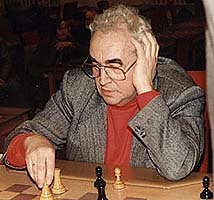
|
Mark Taimanov,
grandmaster |
Fedorov, Alexei (2659) - Gulko, Boris (2618)
FIDE World championship,
Las Vegas, 1999

|
Mark Taimanov,
grandmaster |
1. e4 e6 2. d4 d5 3. Nc3 Bb4 4. e5 c5 5. a3 Bxc3+ 6. bxc3 Ne7 7. Nf3 Qa5
8. Bd2 Nbc6 9. h4 cxd4 10. cxd4 Qa4 11. h5!?
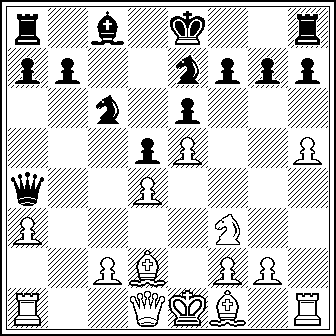
This promising pawn sacrifice (instead of the more hamble 11. Bc3 or 11. Be3 ) was examined many times. Undoubtely, it is attractive for aggresive-style players, like Fedorov. 11...Nxd4 12. Bd3 Nec6 Of course, the pursuit for the second pawn - 12...Nxf3+ 13. Qxf3 Qd4 - is very dangerous. After 14. 13. Kf1 This paradoxical prophylactical maneuver represents the most radical method of the White's play. First of all, threatening is 14. Rh4 . 13...Nf5 Also tested was 13...Nxf3 14. Qxf3 Bd7 (weak is 14...Nxe5 because of 15. Qg3 Qd4 16. Bc3! ), and after 15. h6 White took advantage. 
14. Kg1!? Just this move is a novelty. The game Hellers - Gulko (Biel, 1993) went on with 14. Bxf5 exf5 15. h6 Rg8 16. Bg5 Be6 with double-edged play. But the new plan, introduced by Fedorov and consisted in preparation of active play at the kingside, is much more dynamical and crafty. 14...Qg4 In the case of 14...Bd7 15. Bxf5 exf5 16. h6 Rg8 17. Bg5 Be6 White can successfully attack by 18. hxg7 Rxg7 19. Bf6 . 15. Qe2 f6 Gulko tends to create some counterplay, which is, however, connected with risk, for opening of the position (under Black's development backwardness) suits White. Note that natural 15...Bd7 16. Rb1 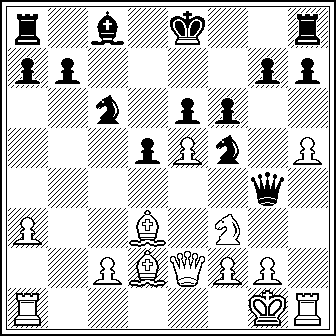
16. h6! fxe5 17. hxg7 Rg8 17...Qxg7 is bad in view of 18. Bxf5 exf5 19. Bc3 . 18. Rxh7 e4 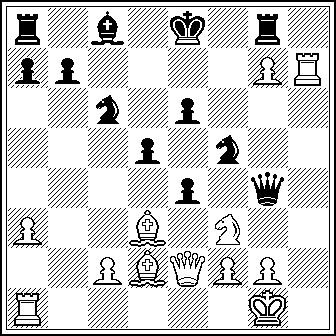
It is clear, that now 18...Rxg7 19. Rxg7 Qxg7 was also unattractive becuase of 20. Bxf5 . 19. Ng5 Qxe2 20. Bxe2 Rxg7 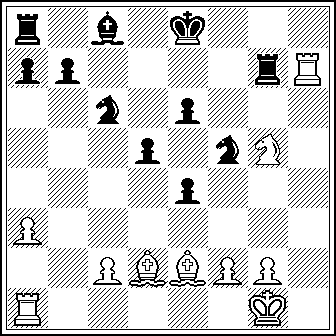
One could feel, Вthat after the queen exchange Black leaves difficulties behind. But, as it is revealed from the remainder of the game, problems of Black are still here, and they are not easily resolved. 21. Rh8+ Ke7 22. f4 
24...exf3? It could be, that this is the incorrigible mistake. The position didn't allow to Black to give freedom to white pieces. 22...b6 was the correct move. 23. Bxf3 Nfd4 24. Bh5 b6 24...Nxc2 is obviously bad because of 25. Rf1 . 25. Re1! 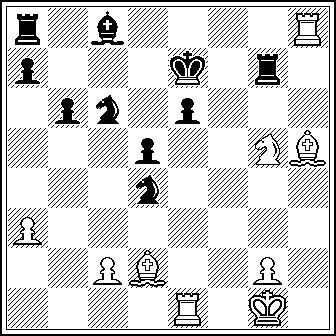
Now, when all white pieces take part in attack, Black is doomed. 25...e5 Neither 25...Bb7 26. Rxa8 Bxa8 27. c3 , nor 25...Nxc2 26. Re8+ Kd6 27. Bf4+ Kc5 28. Rc1 Nd4 29. Bd1 saves. 26. c3 Nb3 27. Bf4 Bb7 
28. Rh6! Rag8 If 28...e4 , then 29. Nxe4! dxe4 30. Rxe4+ Kd7 (or 30...Kd8 31. Rd6+ Rd7 32. Re8+ ) 31. Rd6+ , and White wins. 
29. Bxe5! Rxg5 30. Rh7!+ Ke6 Or 30...Kd8 31. Bf6+ . 
31. Bh2!+ Ne5 32. Bf7+ Kf6 33. Rf1+ Ke7 34. Bxg8+ 1-0 Fedorov carried out his attack brilliantly. |